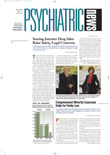To judge from news reports, you might have thought that Toronto, Ontario, in the last months was a city under siege, battened down against an outbreak of severe acute respiratory syndrome (SARS).
And while the outbreak has been a serious problem for health care workers—with significant disruption of normal activity for physicians of all types, including psychiatrists who work in hospital settings—there has been no general spread of the disease into the community.
Psychiatrists who spoke with Psychiatric News suggest that the real story is one of a city that has successfully managed an outbreak of a new and deadly disease that could have been much worse.
Gail Robinson, M.D., echoed the citywide dismay at the World Health Organization’s (WHO) advisory against travel to Toronto—which was lifted at the end of April, then went back into effect in late May because new cases appeared—and said that regarding the community at large, the image of a city under siege was simply false.
“Toronto should be a model of how we have quickly contained something that could have been much worse,” said Robinson, director of the Women’s Mental Health Program at the University Health Network of the University of Toronto.
Robinson said that for the most part, and even during the height of the crisis in March and April, Toronto citizens went about their business, cautious but without alarm. “Our day-to-day life has gone on exactly the same as before,” she said.
“People are cheerful and optimistic,” agreed Donna Stewart, M.D., a professor and chair of women’s health at the University Health Network. “In general, people are handling it well.”
But Robinson said media attention to the outbreak outside the city has been “blown out of proportion,” generating undue concern, including the cancellation of at least one major convention in Quebec City.
According to WHO, travel advisories are issued following consideration of several factors, including the magnitude of probable SARS cases, the last dates of cases of community transmission, and the last dates of export of cases.
On April 29 a statement on the WHO Web site at www.who.int/csr/sarsarchive/2003_04_29/en/ announced the lifting of the travel advisory. “The magnitude of probable SARS cases has decreased,” the WHO statement said. “Twenty days have passed since the last cases of community transmission occurred. No new confirmed exportation of cases has occurred. WHO has also been assured by Canadian authorities that proactive screening measures at airports will be implemented, as recommended by WHO.”
As of May 11, the Canadian Ministry of Health had received reports of 321 probable or suspect cases of SARS in Canada, with 23 deaths. As of that date, transmission was limited to specific transmission settings such as households, hospitals, and specific community settings.
The details of the cases as of last month are as follows:
• Ontario reported 139 probable and 122 suspect cases.
• British Columbia reported four probable and 43 suspect cases.
• Saskatchewan reported one suspect case.
• New Brunswick reported two suspect cases.
• Alberta reported six suspect cases.
• Prince Edward Island reported four suspect cases.
A “suspect” case of SARS is a person who fits into one of the following two categories: a person who develops fever and one or more respiratory symptoms, including cough, shortness of breath, or difficulty breathing, within 10 days of returning from travel to areas in Asia where SARS cases are being reported; or a person who develops fever and one or more respiratory symptoms, including cough, shortness of breath, or difficulty breathing, within 10 days of having had close contact with a “probable” case of SARS.
A “probable” case of SARS is similar to a suspect case, but often involves a more severe illness, with progressive shortness of breath and difficulty breathing, and, in some cases, chest X-rays showing signs of atypical pneumonia.
For the city’s health care workers and many patients seeking care at the city’s hospitals, restrictions designed to contain the disease have been a significant source of disruption. The city’s hospitals were closed to outpatients, forcing some physicians to set up makeshift offices to continue seeing patients.
Robinson established a temporary office in a suite at a nearby Courtyard Marriott Hotel. “I just didn’t feel I could not see any of my patients for a month,” she said. “Patients who were urgent you could see at the hospital, but there are people who are not urgent one day, but who will become urgent if you can’t see them for two or three weeks.”
Stewart and Robinson reported very tight screening restrictions on entering and leaving the hospital and moving from one unit to another. “There has been a complete disruption of our normal clinical activity,” Stewart said.
Predictably, for some psychiatric patients the threat of SARS has been an added burden. “As far as psychiatric patients go, we have the usual situation that people who are already concerned about their health may have exaggerated concerns,” Stewart said. “SARS has given them a lot to work with. People with minor colds now think they are dying of SARS.”
But a report on a retrospective case series of 144 patients admitted to Toronto hospitals—appearing in the May 6 online edition of the Journal of the American Medical Association—paints a picture of a disease that is very serious but from which most people recover.
Of the 144 patients, 111 were exposed to SARS in the hospital setting as health care workers, patients, or visitors. The vast majority (95 percent) received antibiotic therapy during the course of the hospitalization. Most patients (126, or 88 percent) were given Ribavirin. The use of ribavirin was associated with significant toxicity: seventy-one patients experienced a decrease in hemoglobin level of at least 2 g/dl after ribavirin was initiated.
Of the eight patients who died, six had diabetes. Of the other two patients, one had cancer, and the other had no comorbid disease other than being a smoker. ▪
